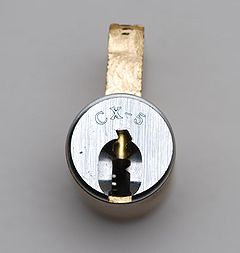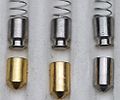Scorpion CX-5: Difference between revisions
No edit summary |
m (Unprotected "Scorpion CX-5": Play nice, please.) |
Revision as of 17:22, 14 December 2010
Scorpion CX-5
| Scorpion CX-5 | |
 | |
| Name | Scorpion CX-5 |
|---|---|
| Manufacturer | Scorpion, Marks USA, CX5 Security |
| Lock Type | Varied |
| Lock Design | Pin-tumbler, Sidebar |
| Year(s) Produced | 2003-Present |
| Patent | US 6,477,876 US D516,897 |
The CX-5 (or CX5) is a UL 437 rated pin-tumbler lock made by CX5 Security in South Korea. It uses six pin-tumblers and five springless finger pins which interface with a sidebar. The CX-5 is functionally identical to the earlier Scanlock design.
The CX-5 is distributed (and sometimes rebranded) by a number of lock manufacturers, such as Marks USA in the United States and Scorpion in Canada.
Principles of operation
The CX-5 uses six pin-tumblers and a sidebar as primary locking components. In function, it is similar to other sidebar-based pin-tumblers, particularly the ASSA Twin 6000 and the Mul-T-Lock MT5+. Both pin-tumblers and sidebar finger pins must be properly positioned to rotate the plug. The CX-5 allows for ten pin-tumbler sizes, for a total of 1,000,000 (106) theoretical key differs. Given a MACS of 6, the real number of key differs is closer to 400,000 for any given sidebar bitting. Driver (top) pins are spooled to frustrate lockpicking attacks. The spool design is similar to those used in the ASSA Twin 6000.
The sidebar is made of steel and positioned at 9 o'clock in the plug. The sidebar interfaces with five finger pins of four possible depths, giving the CX-5 a total of 1024 (45) theoretical sidebar differs. Each finger pin has one true gate and one false (shallow) gate. The key has a milled track on the left hand side that picks up the legs of each finger pins and properly positions their true gates. Finger pins are left springless to promote longevity of the key track and the finger pin legs.[1]
Key pins properly aligned at the shear line.
Notes
- Pin-tumbler bitting codes are designated 0 (0.339") to 9 (0.204"), jumping in incremenents of 0.015".
Disassembly instructions
The CX-5 can be disassembled in the same way as a standard pin-tumbler lock. When a key is not inserted into the exposed plug the springless finger pins and sidebar will fall out of the plug.
- Remove the cam or C-clip.
- Insert the key and turn the plug 45-90 degrees.
- Withdraw the plug from the cylinder. (A plug follower is recommended)
OR
- Remove the chamber casings and take out each pin-stack individually
- Remove the cam or C-clip.
- Withdraw the plug from the cylinder.
Vulnerabilities
The CX-5 may be vulnerable to one of more of the following:
Notes
- Key bumping is only possible given a bump key with the correct sidebar bitting.
Gallery
Finger pins with false gates
References
- ↑ PULFORD, Graham (2007). High Security Mechanical Locks: An Encyclopedic Reference. ISBN 0750684372.







